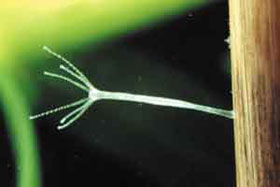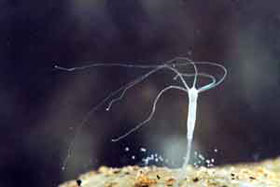Hello, Guest!
Zoological excursions
Coelenterates (Coelenterata)
The overwhelming majority of coelenterates live in seas and oceans. However, a freshwater polyp – hydra is an exception: it inhabits lakes, sometimes it is recorded in sors and bays of Lake Baikal. Hydra belongs to the class Hydrozoa. The hydra body attaches to the substratum with a narrow stalk on the end of which there is a base. On the opposite end of the stalk, there is a mouth opening surrounded by 4-6 tentacles with the help of which the hydra catches a prey – daphnia and other animals, including small tadpoles and fries. As soon as a crustacean touches tentacles of the hydra, on which there are urticant capsules, the latter “discharge” long threads containing a strong poison. Killed animals are pulled to the hydra’s mouth opening and swallowed. The hydra throws undigested remains of food from the mouth “wrinkling” its body. The hydra is able to crawl from place to place sliding on the base or somersaulting. If the hydra is properly fed in the aquarium, its body besides tentacles and a stalk is covered with germs or young daughter individuals. By autumn the hydra starts sex reproduction. At that time, gonads like swellings are visible on its body.
|
A singular polyp - hydra |
Hydra with a daughter individual |
|
Hydra |
Deep water Baikal Hydra sp. |
Copyright © 2005-2010 ЦНИТ ИГУ, 

Дизайн web-студия ЦНИТ ИГУ







